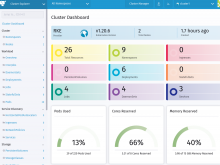If we choose to go to kubernetes, we will probably need to to manage several clusters to isolate the concerns.
For example, we will need at least a production and staging cluster + some sandbox for the developers and tests.
Rancher is supposed to provide a easy way to centralize the cluster management but it need to be tested to see what it's possible.
The firt step is to deploy a basic installation and ply with it but the goal is reply to the following points :
- pro/cons compared to a manual installation
- automation capabilities (are there any integration with terraform or puppet ?)
- operation cost (cost of an upgrade ?)
- ...


